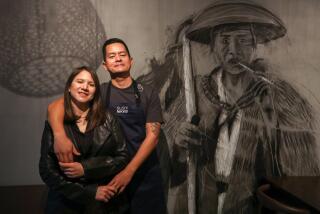In Season/Asian pears : The Exotic Asian Pear Ripens for Big Season
- Share via
The Asian pear, which has only recently been regularly available locally, will be in its prime for the next couple of weeks. The crisp-fleshed fruit has the appearance of an apple and the taste of a juicy pear.
Asian pears prefer cool temperatures, but several North County growers have defied the odds by producing a number of varieties which thrive under local weather conditions. At least a dozen kinds of Asian pears are grown here now.
In Asia, the exotic fruit is commonly referred to as the Sand Pear. It goes by various names in the United States, among them Oriental pear, salad pear, or Chinese pear-apple, with Asian pear the name most commonly used in American supermarkets.
Chinese laborers first imported the fruit when they were brought to California during the Gold Rush. But it wasn’t until the 1920s that the state saw its first commercial orchard of Asian pears and only a decade or so ago that the crop was established in North County.
Frank Lea, one of North County’s first Asian pear growers, was introduced to the fruit while on a military tour of duty in Japan. That led him to plant a few trees as a hobby upon his retirement in San Diego County more than 10 years ago.
“When I first started selling Asian pears, customers knocked over my display tables at the farmers markets,” Shea said. Three years later, he is encountering stiffer competition due to the fruit’s newly-acquired popularity.
In his Valley Center orchard, Lea grows several varieties of Asian pears, among them the Wanashi, Shinseiki, Ishiiwase, 20th Century, and the Chojuro--now the most popular variety grown in California. “I’ve had some Chojuro weigh up to three pounds apiece,” he said. “In Japan, they are raised inside a wax-lined bag to ensure a perfectly smooth skin, and sell for up to $3 apiece.”
Bunny Varn, owner of the Apple Stop in Valley Center, experimentally planted Asian pears about seven years ago. “Fruit experts from UC Davis were incredulous when they heard I had over 300 Asian pear trees. They couldn’t believe the fruit would grow in such a warm climate. I’ve sold some of our trees to people all the way to the border, and as far east as Yuma. They do wonderfully.”
Her experiment turned into a thriving business. Although Varn welcomes buyers at her fruit stand, she ships most of her organically grown fruit to Los Angeles markets. Her Asian customers prefer the Shinko, “the Cadillac of Asian pears,” she said, while she is especially fond of the best-selling Shinseiki. “I really like them all,” she adds, cupping her hands around an Ishiiwase the size of a grapefruit. “The fruit is ripe when it gives a little,” she explains, “but it mustn’t feel soft to the touch.”
There are dramatic differences in appearance, and subtle variations in taste among Asian pears.
A mottled-yellow skin characterizes the popular 20th Century, said to be among the juiciest of the Asian pears. The orange-russeted Chojuro is known for its grittier flesh and juiciness. The orangish-tan Ishiiwase boasts juiciness and a mild flavor, and sometimes weighs up to two pounds. The Toma Red, developed in the Central California Valley, derives its name from its reddish tinge. The Shinseiki, the original variety planted in California, is recognizable by its yellow color, and while not as juicy as the other varieties, it still ranks high among experts for its crisp, fresh taste.
While you can bite into an Asian pear just as you would an apple, the peel of the Chojuro is astringent, and should be removed first.
Look for a nice uniform size and a blemish-free skin when buying Asian pears. “The slightest scratch turns to a blemish,” said Lea. “The fruit requires very careful handling.”
Asian pears, a good source of vitamin C, add an exotic crispness to fruit salads. The fruit stays crisp for up to 14 days at room temperature. Some varieties, such as the Chojuro or the Shinseiki, stay crisp in the vegetable bin of the refrigerator for up to two months.
Bunny Varn claims to have kept some Asian pears refrigerated for up to eight months. “I forgot a case in the back of a cooler and found them again eight months later,” she says. “The fruit tasted perfectly all right.”
LOCALLY GROWN ASIAN PEARS
Frank Lea, Sha Lea Orchards, 10530 W. Lilac Road, Fallbrook, CA 92082. Customers can’t pick their own fruit, but Lea will pick them when given a day’s notice. Calls: 749-0243. Lea also sells at area farmer’s markets. Price depends on size. Small Chojuro: 75 cents a pound; small 20th Century: 75 cents a pound; larger Shinseiki and Ishiiwase, $1 a pound.
Bunny Varn, The Apple Stop, 30027 Wilkes Road, Valley Center 92082. Calls: 749-1952. All organically grown. $1.50 a pound for all varieties.
Encinitas Community Market, 745 First Street, (in the Lumberyard), Encinitas, 92028. Calls: 753-4632. Organically grown Shinseiki are $2.59 a pound.
More to Read
Eat your way across L.A.
Get our weekly Tasting Notes newsletter for reviews, news and more.
You may occasionally receive promotional content from the Los Angeles Times.









